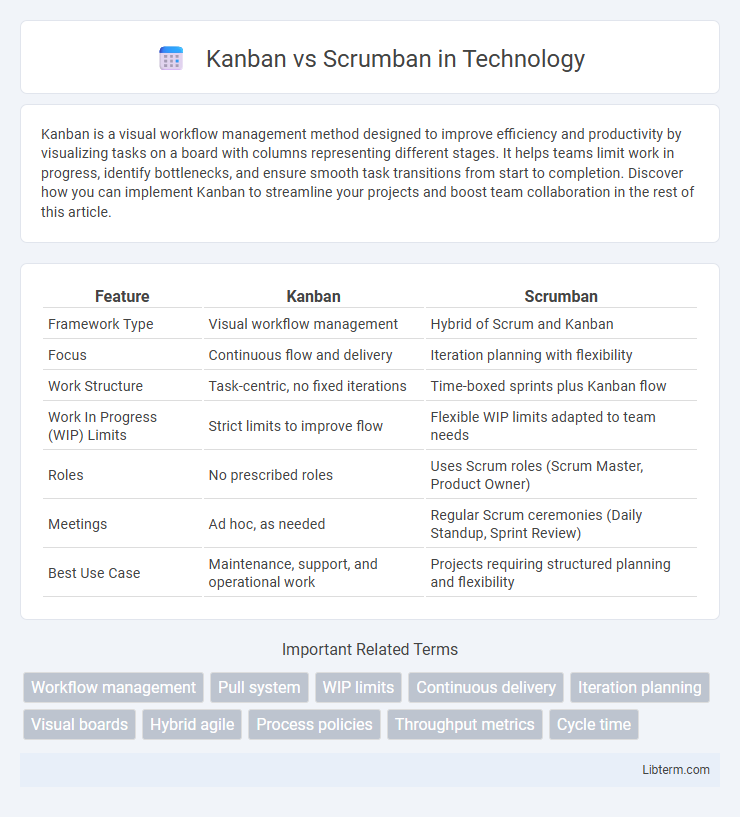Kanban is a visual workflow management method designed to improve efficiency and productivity by visualizing tasks on a board with columns representing different stages. It helps teams limit work in progress, identify bottlenecks, and ensure smooth task transitions from start to completion. Discover how you can implement Kanban to streamline your projects and boost team collaboration in the rest of this article.
Table of Comparison
| Feature | Kanban | Scrumban |
|---|---|---|
| Framework Type | Visual workflow management | Hybrid of Scrum and Kanban |
| Focus | Continuous flow and delivery | Iteration planning with flexibility |
| Work Structure | Task-centric, no fixed iterations | Time-boxed sprints plus Kanban flow |
| Work In Progress (WIP) Limits | Strict limits to improve flow | Flexible WIP limits adapted to team needs |
| Roles | No prescribed roles | Uses Scrum roles (Scrum Master, Product Owner) |
| Meetings | Ad hoc, as needed | Regular Scrum ceremonies (Daily Standup, Sprint Review) |
| Best Use Case | Maintenance, support, and operational work | Projects requiring structured planning and flexibility |
Introduction to Kanban and Scrumban
Kanban is a visual workflow management method that emphasizes continuous delivery, limiting work in progress, and improving efficiency by visualizing tasks on a Kanban board. Scrumban combines Scrum's structured sprint framework with Kanban's flexibility, offering teams iterative cycles while maintaining flow-based work management. This hybrid approach enhances adaptability and supports incremental improvements in project delivery.
Core Principles of Kanban
Kanban's core principles emphasize visualizing workflow to enhance transparency and identify bottlenecks, allowing teams to manage work in progress (WIP) limits effectively to prevent overload. It promotes continuous delivery by optimizing the flow and making incremental improvements based on real-time feedback, ensuring adaptability without prescriptive roles or iterations. In contrast, Scrumban combines these Kanban principles with elements of Scrum, such as time-boxed iterations, providing a hybrid approach that supports both flow efficiency and structured sprint planning.
Key Concepts of Scrumban
Scrumban integrates key concepts from both Scrum and Kanban, emphasizing continuous workflow and pull-based task management from Kanban while retaining Scrum's iterative planning and review cycles. Key elements include visual task boards with WIP (Work In Progress) limits to optimize efficiency, combined with regular backlog refinement and sprint-based goals to maintain structure. This hybrid approach enhances flexibility and adaptability, making it suitable for teams transitioning from Scrum to Kanban or seeking a balanced agile framework.
Workflow Visualization: Kanban vs Scrumban
Kanban uses a continuous workflow visualization with columns representing each stage of the process, enabling teams to track work-in-progress and optimize flow efficiently. Scrumban combines Kanban's visual board with Scrum's iterative cycles, allowing for flexible work item prioritization while maintaining clear task visibility. Both methods enhance transparency by visually managing tasks, but Scrumban adds structure through timeboxed iterations for improved planning and review.
Flexibility and Adaptability Comparison
Kanban offers high flexibility by allowing continuous workflow adjustments without fixed iterations, making it ideal for dynamic projects with evolving priorities. Scrumban combines Scrum's structured sprints with Kanban's visual workflow management, enhancing adaptability by enabling teams to switch between iterative planning and continuous delivery based on project needs. This hybrid approach allows teams to optimize resource allocation and respond swiftly to changing requirements, balancing predictability with flexibility.
Planning and Estimation Differences
Kanban emphasizes continuous workflow with no fixed timeframes, making planning and estimation flexible and adaptive to real-time changes. Scrumban integrates Scrum's iterative sprint planning and estimation techniques into Kanban's flow, providing a structured cadence for task prioritization and capacity forecasting. This hybrid approach allows teams to utilize story points or time-boxed iterations for more predictable delivery while maintaining Kanban's visual workflow management.
Managing Work-in-Progress Limits
Kanban strictly enforces Work-in-Progress (WIP) limits to optimize flow and reduce bottlenecks, ensuring teams focus on completing tasks before starting new ones. Scrumban, blending Scrum and Kanban, offers flexible WIP limits that adapt to changing workloads and team capacity, promoting continuous improvement and responsiveness. Both methodologies leverage WIP limits as a core mechanism to balance workload, improve efficiency, and enhance delivery predictability.
Roles and Responsibilities in Each Approach
Kanban emphasizes continuous workflow management with fluid roles where team members focus on limiting work in progress and optimizing task completion without rigid role definitions. Scrumban integrates Scrum's fixed roles such as Product Owner, Scrum Master, and Development Team while utilizing Kanban's visual workflow and flexibility to adapt responsibilities based on project demands. In Scrumban, roles maintain accountability for sprint planning and backlog grooming, whereas Kanban promotes shared responsibility for flow efficiency and incremental improvements.
Best Use Cases: When to Choose Kanban or Scrumban
Kanban is best suited for teams with continuous workflow requiring visual task management and flexibility without fixed iterations, such as support or maintenance teams. Scrumban blends Scrum's iteration structure with Kanban's flow-based approach, ideal for teams transitioning from Scrum, managing unpredictable workloads, or needing both predictable delivery and adaptability. Choosing Kanban or Scrumban depends on workflow stability, team maturity, iteration needs, and the balance between planning and flexibility.
Conclusion: Selecting the Right Method for Your Team
Kanban offers a visual workflow system ideal for teams seeking continuous delivery and flexibility without fixed iterations, while Scrumban blends Scrum's structured sprint planning with Kanban's adaptability, making it suitable for teams transitioning from Scrum or requiring more agility. Selecting the right method depends on your team's need for predictability, iterative planning, and process improvement frequency. Teams prioritizing clear roles and time-boxed cycles may prefer Scrumban, whereas those emphasizing flow efficiency and real-time task management might benefit more from Kanban.
Kanban Infographic

 libterm.com
libterm.com